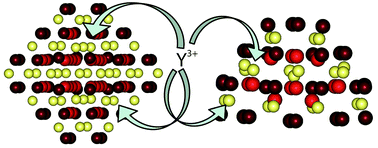Structure and reducibility of yttrium-doped cerium dioxide nanoparticles and (111) surface†
Abstract
Using periodic density functional calculations, we studied the local structure and preferred locations of yttrium cations and oxygen vacancies in Y-doped cerium dioxide. We employed three kinds of models – a slab of the CeO2(111) surface and two ceria nanoparticles of different sizes and shapes. In the slab models, which represent the (111) surface of ceria and the corresponding extended terraces on the facets of its nanoparticles, Y3+ cation dopants were calculated to be preferentially located close to each other. They tend to surround a subsurface oxygen vacancy that forms to maintain the charge balance. Such general behavior was not found for the nanoparticle models, in which structural flexibility and the presence of various low-coordinated surface centers seem to be crucial and suppress most of the trends. Configurations with four Y3+ cations were calculated to be particularly stable when they combined two of the most stable configurations with two Y3+ cations. However, no clear trend was found regarding the preferential spatial distribution of the Y3+ pairs – they can be stable both in isolation and close to each other. In general, doping by yttrium does not notably change the reducibility of ceria systems but selectively facilitates the formation of oxygen vacancies at the ceria surface in comparison with pristine ceria. Yttrium cations also slightly increase the basicity of the nearby oxygen centers with respect to a stoichiometric ceria surface.



 Please wait while we load your content...
Please wait while we load your content...